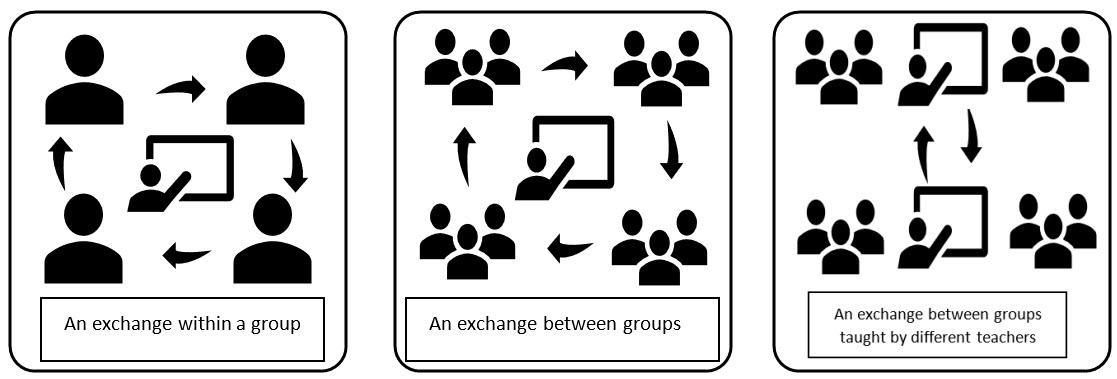More on pen pals:
- Start a Pen Pal Exchange project for students on the Virtual Writing Tutor.
- For instructions on how to create a pen pal exchange for your students, check out these step-by-step pen pal exchange creation instructions for teachers.
- Click here for an article on pen pals that students can read to introduce them to the concept of pen pal writing.
For ESL/EFL instructors teaching beginners, finding authentic and meaningful communicative writing tasks can be difficult. One challenge is figuring out how to keep a substantial conversation going. Social media posts are often short, eliciting short comments and likes. Emails are often utilitarian vehicles for conveying digital information, with file attachments, or for making requests. They do not lend themselves to extended, deeply meaningful exchanges that sustain students’ interest over long periods of time. Blog writing and hypertext narrative writing tasks are different, but these are written equivalents of monologues, a type of one-way communication for broadcasting to the masses.
And yet, Applied Linguistics has taught us that languages are best taught by maximizing the repeated exchange of meaningful messages with a focus on form, right? Isn’t it strange, then, that when we teach writing, many of us teachers focus primarily on structure, form, accuracy, and critical thinking? Strange, but unsurprising because engaging, meaningful, focused, authentic writing tasks are hard to come by. How can we make writing meaningful, repetitive, form-focused, and engaging for learners?

Instead of resorting to 5-paragraph essay writing activities, a discourse model that does not exist in the wild, we can support the development of Basic Interpersonal Communication Skills (BICS) with online pen pal writing tasks instead.
Think about it. Pen pals usually live far from each other and so try to convey their day-to-day lives through letters. Pen pals often try to communicate who they are, their culture, their family, food, holidays, and life events–this is all basic, interpersonal stuff! So pen pal writing projects seem really well-suited for learners trying to develop their BICS.
The obvious problem with pen pal writing is that it takes a long time before letters in the mail arrive where they are going, and longer still to get a reply. There are only so many weeks in a semester, so pen pal writing is impractical for instructed language learning contexts. It is something a learner might do in addition to an English Second Language course, right? Maybe not. Maybe there is still a way to integrate pen pal writing into an ESL course.

Maximizing Repetitions
Sending letters internationally takes about two weeks. Pen pals cannot, therefore, expect more than one letter a month. In terms of maximizing meaningful, form-focused repetitions, college writing teachers won’t get much in a three-month English Second language course. Something needs to be done to maximize the number of exchanges.

A colleague of mine gets students to write messages to anonymous pen pals in their Hilroy notebook as informal writing practice. He collects the notebooks and redistributes them to students in another group on a different day. They write replies or questions, and he collects them back up again and returns them to the original author. It is a lot to keep track of, but the students enjoy it he says–and I believe him! At the end of the semester, he arranges for the pen pals to meet each other at an end-of-semester party.
The Pedagogy of Notebook Pen Pal Exchanges
For the record, I love the idea of notebook pen pal exchanges because of the meaningful exchanges it produces. However, I have not implemented this activity in any of my courses because I can’t figure out how to ensure that it prepares students for competency-based writing evaluations in a direct and coherent way. General, unfocused language practice is not the highest expression of good CLT pedagogy, is it
Here are a few thoughts on my pedagogical concerns with notebook pen pal exchanges at the college level. Later, I will propose a solution that should improve upon this otherwise excellent activity.
- Not evaluated: Since this type of pen pal writing is framed as informal writing practice, it doesn’t count toward the student’s final score. What counts instead are formal essay assignments during midterm and final exams. As such, pen pal writing reduces the cohesion of a course. Students’ pen pal writing does not prepare them for writing that counts. Since the meaningful exchange does not prepare students for competency-based evaluations, its value is restricted only contributing only to general proficiency and a reduction to writing apprehension.
- Feedback on errors: Giving corrective feedback on weekly writing has proven impossible for my colleague. There is just too much writing to correct, so he doesn’t. This makes pen pal writing ineligible for evaluation. If students don’t get formative feedback, pen pal writing tasks cannot be used for summative evaluations.
- Feedback on target structures: Students are invited to use the grammar from the lesson, but there is no follow-up on the use of the targets.
- Drop-outs: Some students go missing for a week or two. Since he keeps the notebooks in his office, students can’t participate in the exchange if they are absent. Some students drop out of the course and notebook pen pal exchanges become difficult to manage. Some students complain that their pen pal is delinquent. the teacher is quick to pair students up or substitute another pen pal who also lost a partner.
Designing an Online Pen Pal Exchange for ESL Learners
What’s needed, obviously, is a system that can match up students in the same class and or in other countries. Also, there needs to be a way to provide fast feedback on spelling errors and grammar errors, so that students can get help with their extensive grammar errors. Indeed, it would be useful to know if students are writing more than the minimum number of words. Short messages won’t do. Finally, there needs to be a way of ensuring that students use the grammar and vocabulary that they learn in their lessons because of the problem of grammar avoidance.

Sounds like a job for the Virtual Writing Tutor, right? The Virtual Writing Tutor grammar checker can already, count words, check spelling and grammar, and check for target structures. All that’s needed, then, is a way to match students up and track their progress.
Introducing the Virtual Writing Tutor Pen Pal Exchange Project. Designed for ESL teachers, by an ESL teacher, the system can match up students within the same class or from different classes taught by other teachers. All they need is a free account. It can also, check

Find out how to create an ESL pen pal exchange
